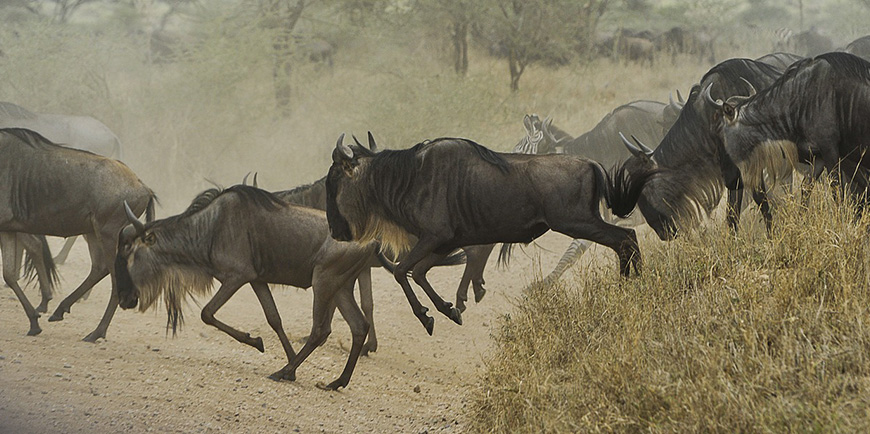
The Serengeti National Park is a Tanzanian national park in the Serengeti ecosystem in the Mara and Simiyu regions. It is famous for its annual migration of over 1.5 million white bearded (or brindled) wildebeest and 250,000 zebra and for its numerous Nile crocodile.
History
The Maasai people had been grazing their livestock in the open plains of eastern Mara Region, which they named “endless plains”, for around 200 years when the first European explorer, Austrian Oscar Baumann, visited the area in 1892. The name “Serengeti” is an approximation of the word used by the Maasai to describe the area, siringet, which means “the place where the land runs on forever”.
The first Briton to enter the Serengeti, Stewart Edward White, recorded his explorations in the northern Serengeti in 1913. He returned to the Serengeti in the 1920s and camped in the area around Seronera for three months. During this time, he and his companions shot 50 lions.
Because the hunting of lions made them scarce, the British colonial administration made a partial game reserve of 800 acres (3.2 km2) in the area in 1921 and a full one in 1929. These actions were the basis for Serengeti National Park, which was established in 1951.
The Serengeti gained more fame after the initial work of Bernhard Grzimek and his son Michael in the 1950s. Together, they produced the book and film Serengeti Shall Not Die, widely recognized as one of the most important early pieces of nature conservation documentary.
To preserve wildlife, the British evicted the resident Maasai from the park in 1959 and moved them to the Ngorongoro Conservation Area. There is still considerable controversy surrounding this move, with claims made of coercion and deceit on the part of the colonial authorities.
The park is Tanzania’s oldest national park and remains the flagship of the country’s tourism industry, providing a major draw to the Northern Safari Circuit encompassing Lake Manyara National Park, Tarangire National Park, Arusha National Park and theNgorongoro Conservation Area. It has over 2,500 lions and more than 1 million wildebeest.
Geography
The park covers 14,750 square kilometres (5,700 sq mi)[7] of grassland plains, savanna, riverine forest, and woodlands. The park lies in northwestern Tanzania, bordered to the north by theKenyan border, where it is continuous with the Maasai Mara National Reserve. To the southeast of the park is the Ngorongoro Conservation Area, to the southwest lies Maswa Game Reserve, to the west are the Ikorongo and Grumeti Game Reserves, and to the northeast and east lies theLoliondo Game Control Area. Together, these areas form the larger Serengeti ecosystem.
The park is usually described as divided into three regions:
• Serengeti plains: the almost treeless grassland of the south is the most emblematic scenery of the park. This is where the wildebeest breed, as they remain in the plains from December to May. Other hoofed animals – zebra, gazelle, impala, hartebeest, topi, buffalo, waterbuck – also occur in huge numbers during the wet season. “Kopjes” are granite florations that are very common in the region, and they are great observation posts for predators, as well as a refuge for hyrax and pythons.
• Western corridor: the black clay soil covers the swampy savannah of this region. The Grumeti River is home to Nile crocodiles, colobus monkeys, hippopotamus, and martial eagles. The migration passes through from May to July.
• Northern Serengeti: the landscape is dominated by open woodlands (predominantly Commiphora) and hills, ranging from Seronera in the south to the Mara River on the Kenyan border. Apart from the migratory wildebeest and zebra (which occur from July to August, and in November), the bushy savannah is the best place to find elephant,giraffe, and dik dik.
Human habitation is forbidden in the park with the exception of staff for the Tanzania National Parks Authority, researchers and staff of the Frankfurt Zoological Society, and staff of the various lodges, campsites and hotels. The main settlement is Seronera, which houses the majority of research staff and the park’s main headquarters, including its primaryairstrip.
Wildlife
As well as the migration of ungulates, the park is well known for its healthy stock of other resident wildlife, particularly the “big five”, named for the five most prized trophies taken by hunters:
• Masai lion: the Serengeti is believed to hold the largest population of lions in Africa due in part to the abundance of prey species. More than 3,000 lions live in this ecosystem.
• African leopard: these reclusive predators are commonly seen in the Seronera region but are present throughout the national park with the population at around 1,000.
• African bush elephant: the herds are recovering from population lows in the 1980s caused bypoaching and are largely located in the northern regions of the park.
• Eastern black rhinoceros: mainly found around the kopjes in the centre of the park, very few individuals remain due to rampant poaching. Individuals from the Masai Mara Reserve cross the park border and enter Serengeti from the northern section at times.
• African buffalo: still abundant and present in healthy numbers.

